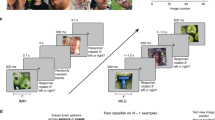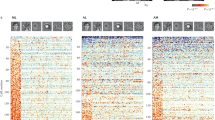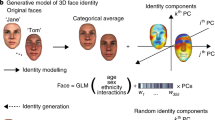Abstract
Faces and bodies are perhaps the most salient and evolutionarily important visual stimuli. Using human functional imaging, we found that the strength of face and body representations depends on long-term experience. Representations were strongest for stimuli in their typical combinations of visual field and side (for example, left field, right body), although all conditions were simply reflections and translations of one another. Thus, high-level representations reflect the statistics with which stimuli occur.
This is a preview of subscription content, access via your institution
Access options
Subscribe to this journal
Receive 12 print issues and online access
$209.00 per year
only $17.42 per issue
Buy this article
- Purchase on Springer Link
- Instant access to full article PDF
Prices may be subject to local taxes which are calculated during checkout


Similar content being viewed by others
References
Cerf, M., Harel, J., Einhauser, W. & Koch, C. in Advances in Neural Information Processing Systems (eds Platt, J.C., Koller, D., Singer, Y. & Roweis, S.) (MIT Press, Cambridge, Massachusetts, 2008).
Peelen, M.V. & Downing, P.E. Nat. Rev. Neurosci. 8, 636–648 (2007).
Kanwisher, N. & Yovel, G. Philos. Trans. R. Soc. Lond. B Biol. Sci. 361, 2109–2128 (2006).
Harley, E.M. et al. Cereb. Cortex 19, 2746–2754 (2009).
Gauthier, I., Skudlarski, P., Gore, J.C. & Anderson, A.W. Nat. Neurosci. 3, 191–197 (2000).
Baker, C.I. et al. Proc. Natl. Acad. Sci. USA 104, 9087–9092 (2007).
Gauthier, I., Tarr, M.J., Anderson, A.W., Skudlarski, P. & Gore, J.C. Nat. Neurosci. 2, 568–573 (1999).
Op de Beeck, H.P., Baker, C.I., DiCarlo, J.J. & Kanwisher, N.G. J. Neurosci. 26, 13025–13036 (2006).
Chan, A.W., Peelen, M.V. & Downing, P.E. Neuroreport 15, 2407–2410 (2004).
Saxe, R., Jamal, N. & Powell, L. Cereb. Cortex 16, 178–182 (2006).
Haxby, J.V. et al. Science 293, 2425–2430 (2001).
Taylor, J.C., Wiggett, A.J. & Downing, P.E. J. Neurophysiol. 98, 1626–1633 (2007).
Urgesi, C., Calvo-Merino, B., Haggard, P. & Aglioti, S.M. J. Neurosci. 27, 8023–8030 (2007).
Shmuelof, L. & Zohary, E. J. Neurosci. 26, 9736–9742 (2006).
Shmuelof, L. & Zohary, E. Nat. Neurosci. 11, 1267–1269 (2008).
Acknowledgements
We thank M. Behrmann, P. Downing, S. Gotts, A. Ghuman, A. Martin, H.P. Op de Beeck and W.K. Simmons for comments on an earlier version of this manuscript and N. Kriegeskorte for helpful discussions. We also thank V. Elkis for assistance with fMRI data collection. This work was supported by the US National Institutes of Health Intramural Research Program of the National Institute of Mental Health.
Author information
Authors and Affiliations
Contributions
A.W.-Y.C., D.J.K., S.T. and C.I.B. designed the fMRI study. A.W.-Y.C., D.J.K. and S.T. collected and analyzed the fMRI data. A.W.-Y.C., D.J.K., J.A. and C.I.B. designed the behavioral study. J.A. collected and analyzed the behavioral data with help from A.W.-Y.C., D.J.K. and C.I.B. A.W.-Y.C., D.J.K. and C.I.B. wrote the paper with contributions from S.T. and J.A.
Corresponding author
Ethics declarations
Competing interests
The authors declare no competing financial interests.
Supplementary information
Supplementary Text and Figures
Supplementary Figures 1–15, Supplementary Data 1–11 and Supplementary Methods (PDF 3148 kb)
Rights and permissions
About this article
Cite this article
Chan, AY., Kravitz, D., Truong, S. et al. Cortical representations of bodies and faces are strongest in commonly experienced configurations. Nat Neurosci 13, 417–418 (2010). https://doi.org/10.1038/nn.2502
Received:
Accepted:
Published:
Issue Date:
DOI: https://doi.org/10.1038/nn.2502
This article is cited by
-
Moving a missing hand: children born with below elbow deficiency can enact hand grasp patterns with their residual muscles
Journal of NeuroEngineering and Rehabilitation (2024)
-
Perceptual aftereffects of adiposity transfer from hands to whole bodies
Experimental Brain Research (2023)
-
Direct comparison of contralateral bias and face/scene selectivity in human occipitotemporal cortex
Brain Structure and Function (2022)
-
Object representations in the human brain reflect the co-occurrence statistics of vision and language
Nature Communications (2021)
-
Seeing faces is necessary for face-domain formation
Nature Neuroscience (2017)



